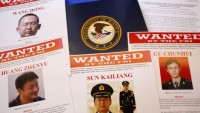No One Remains Anonymous on the Internet, and that’s Dangerous
| Arthur Dominic Villasanta | | Oct 27, 2016 10:37 PM EDT |
(Photo : Getty Images) A security expert claimed that cybercriminals using the ransomware tactic have amassed a collective bounty of about $1 billion in 2016.
Anonymity on the internet is next to impossible and a team of researchers from Stanford and Princeton have conducted a study to prove it.
Over the summer, the team launched what they called the "Footprints Project," which invited individuals to participate in an online experiment that allowed researchers to access their anonymous web browsing history, including information about active Twitter usage.
Like Us on Facebook
Based on that information alone, Footprints successfully identified 11 out of 13 people who visited the site on its first day of operation.
This project is part of a growing body of research that brings heightened alarm to privacy vulnerabilities on the web. The Footprints researchers know online privacy risks aren't new, but their latest research is "another nail in the coffin" to the idea the average person with the average web browser can be private online
"I think the first thing I messaged was: 'This is kind of scary,'" said Stanford undergraduate Ansh Shukla, a senior studying mathematics, who is working on the project with Stanford Engineering assistant professor Sharad Goel and Stanford computer science PhD student Jessica Su.
Researchers ended the Footprints experiment in October. By then almost 300 users had visited the site, and the system had accurately identified 80 percent of them.
How did it work? Users voluntarily participated in Footprints. That gave the researchers permission to gather the names of any websites that a participant clicked on through Twitter while using Google Chrome.
This unique set of links is a fingerprint. To find that user, researchers crawled through millions of Twitter profiles to see who everyone is following.
So imagine that Jane Doe, John Smith and Susie Q all participated anonymously, and that each of these three volunteers follow 100 Twitter accounts.
All three might follow the official Stanford Engineering Twitter account. But Jane and John also follow the New York Times' Twitter account for their news, while Susie instead follows the Los Angeles Times as her newspaper of choice.
Researchers can then deduce that the person who visited links tweeted from Stanford Engineering and the New York Times is more likely to be Jane or John, not Susie.
"Although we happen to use Twitter, it's not like Twitter is uniquely vulnerable," said Shukla. "It doesn't take a lot of recorded characteristics to have people become unique."
For most websites we visit, we often implicitly consent to be tracked through a terms of service or "cookie" (a small file of identifying information left on a computer when you browse online) policy.
Footprints researcher Arvind Narayanan, an assistant professor of computer science at Princeton, previously published a paper that demonstrated how data anonymization is broken on the web. The work became well known outside of academia because Narayanan cross-referenced Netflix user data with Internet Movie Database (IMDb) users to uniquely identify individuals.
"You should kind of go into the internet assuming that everything you go to someone might learn about someday," said Shukla.
While many advertisers and internet companies might not initially know your name, they likely have most of your anonymous browsing history -- even if you regularly clear your cookies.
Shukla hopes that as people realize how easy it is to track their digital footprints, this will lead to a change of policy, such as collecting far less data.
He also envisions new technologies to empower consumers that are more powerful than the "do not track" setting on browsers -- an injunction often ignored by websites.
"Security theater," noted Shukla.
Goel notes that most people don't even realize they are leaving behind digital footprints.
"We conceived this as a consciousness-raising project," he said, adding that he and his team plan to write a journal article about the Footprints experiment.
TagsAnonymity, Internet, stanford, Princeton, Footprints Project, Online privacy, Cookies
©2015 Chinatopix All rights reserved. Do not reproduce without permission
 China State Hackers Try and Fail to Steal Secrets from US Aircraft Carrier Patrolling South China Sea
China State Hackers Try and Fail to Steal Secrets from US Aircraft Carrier Patrolling South China Sea Hackers Almost Cripple the Internet by Weaponizing IoT Devices as Botnets
Hackers Almost Cripple the Internet by Weaponizing IoT Devices as Botnets CIA to Punish Russia with Destructive Cyber Counterattack for Hacks
CIA to Punish Russia with Destructive Cyber Counterattack for Hacks DARPA has Just Developed Hack Proof Code and Proved it Works
DARPA has Just Developed Hack Proof Code and Proved it Works
EDITOR'S PICKS
-

Did the Trump administration just announce plans for a trade war with ‘hostile’ China and Russia?
-

US Senate passes Taiwan travel bill slammed by China
-

As Yan Sihong’s family grieves, here are other Chinese students who went missing abroad. Some have never been found
-

Beijing blasts Western critics who ‘smear China’ with the term sharp power
-

China Envoy Seeks to Defuse Tensions With U.S. as a Trade War Brews
-

Singapore's Deputy PM Provides Bitcoin Vote of Confidence Amid China's Blanket Bans
-

China warns investors over risks in overseas virtual currency trading
-

Chinese government most trustworthy: survey
-

Kashima Antlers On Course For Back-To-Back Titles
MOST POPULAR
LATEST NEWS
Zhou Yongkang: China's Former Security Chief Sentenced to Life in Prison

China's former Chief of the Ministry of Public Security, Zhou Yongkang, has been given a life sentence after he was found guilty of abusing his office, bribery and deliberately ... Full Article
TRENDING STORY

China Pork Prices Expected to Stabilize As The Supplies Recover

Elephone P9000 Smartphone is now on Sale on Amazon India

There's a Big Chance Cliffhangers Won't Still Be Resolved When Grey's Anatomy Season 13 Returns

Supreme Court Ruled on Samsung vs Apple Dispute for Patent Infringement

Microsoft Surface Pro 5 Rumors and Release Date: What is the Latest?










